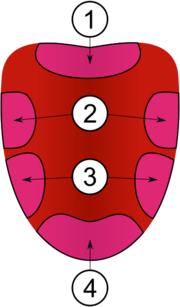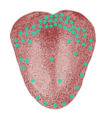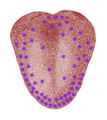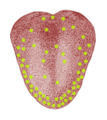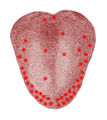Tantalizing Taste Buds
| Instant wiki maker | Making handouts | Editing tips |
Biology In Elementary Schools is a Saint Michael's College student project from a course that ran between 2007 and 2010 and fully described in this book chapter. The student-created resources have been preserved here for posterity. Link under 'toolbox' for printer-friendly versions of the exercises. Click on handouts to print full resolution versions. Please see Wikieducator's disclaimer, our safety statement, and the Creative Commons licensing in English and in legalese.
Student worthiness
Tried and trusted
Primary biological content area covered
This experiment was developed for 1st grade students.
This activity begins an exploration of the 5 senses with a focus on taste. Students will be able to understand a variety of tastes and see where the receptors for each particular taste are on the tongue.
Materials
Teacher's Use:
- Gloves
- Handwashing station
- Q-tips for each student
- Cups for each flavor, each marked with one of the four colors
- Flavors: sugar, salt, coffee, lemon
- Taste bud poster
Student's Use:
- Handout with blank tongue
- Blind Fold
- 4 Different Color Stickers
- 4 Different Color Markers
Handouts
The link to the right is a diagram of the tongue and will be handed out to the students to record their findings.
Description of activity
This activity’s aim is to explore one of the five senses; taste. Students will be blindfolded and have one of four water solutions presented on the four areas on their tongues. The students will record at what point on their tongue they begin to taste something and what it is that they taste. This will be repeated with each solution and all of the data will be graphed.
Lesson plan
Grade: 1st Time: 20 Minutes
4 minutes:
- Introduce activity to students
- Read literature providing background information on Taste
- Explain where the taste receptors are located on the tongue
- Explain what the students will be doing with their own blank maps.
- Have a teacher example the activity.
10 minutes:
- Blind fold students
- Place the flavor on each of the students tongue.
- When students think they know what taste it is (bitter, sweet, salty, or sour) have them identify it on their blank tongue hand out.
- Repeat this process until students have experimented with each liquid flavor.
6 minutes:
- Ask students what they have found about their taste receptors
- Can they identify what is bitter, sweet, salty or sour?
- How do their hand outs compare to the poster made by the teachers?
- Explain importance of this activity.
- Have students wash their hands before moving on to the next scientific experiment.
Potential pitfalls
When working with young children, there will always be the possibility of lack of cooperation. Because we will be asking the students to put unknown solutions into their mouths, some children may be unwilling to take this risk. This can be avoided by having an adult be a test subject to show the children that nothing harmful or too distasteful will be put into their mouths.
Math connections
The students will be able to graph their results on a blank tongue chart. As the student tastes each flavor, they will label the part of the tongue in which that flavor was the strongest. After each student has graphed their results, we will look at a tongue that has been previously labeled with all of the correct taste bud receptors. We can then compare results. Aside from graphing the results of the taste tests, students can conduct a class-wide survey in which each student determines his or her favorite/ least favorite flavor (sour, bitter, salty, sweet). These results can then be plotted on a bar graph or pie chart.
Literature connections
A great segway to this experiment is through literature. Literature, plays in an important role in the enhancement of student learning. A great book to tie this experiment to literature is through Angela Royston's book;The Senses:Taste. Royston's book is filled with pictures and detailed information on how the sense of taste works. It discusses taste buds receptors, different tastes, and how the sense of smell is connected to taste.
Find This Book:
Royston,Angela. The Senses: Taste Black Rabbit Books, 2005
Connections to educational standards
Vermont's Framework of Standards and Learning Opportunities: Science, Mathematics, and Technology Standards
7.14 The Human Body- ---Students demonstrate understanding of the human body- heredity, body systems, and individual development- and understand the impact of the environment on the human body.---
Mater Christi School Standards-
Core Standard #1: The Human Body
Topics and Concepts- The Five Senses --- Taste
Next steps
As this activity begins an exploration on one of the five senses, students may be curious to explore the other 4 senses. Activities that explore these senses would be an excellent continuation of this lesson.
Reflections
This experiment was run on February 4th with a large group of first graders from the Mater Christi School in Burlington, Vermont. This experiment ran very smoothly and the children enjoyed exploring their taste buds. Because children were arriving at the school at different times, the groups of children had differing amounts of time to spend on our experiment. The first group had more time than needed and our back up activity of coloring on the back of their "tongue sheets" was used. Other groups did not have enough time and we had to cut out less pertinent parts of the story "Taste" to make sure each child got a turn trying out their taste buds. Most children were very compliant and had no trouble completing the activity although a few children did not feel comfortable with blind folds and they ran the experiment with their eyes open. The children loved getting to use stickers to mark on a large chart their own experiences, I would highly recommend doing this. The students had obviously studied the human body because when prompted about the five senses, the children did have some basic background knowledge. This knowledge was enriched with the text read at the beginning of the experiment and the hands on activities done by the children. I would also strongly suggest giving the students some background knowledge about taste and taste buds before diving into an activity. Having this knowledge will make the experiment more meaningful to the students.
- TTBudsimage 1.JPG
Figure 10 Experimenters
Citations and links
See Also:
Michigan Reach Out! Activities
| Work in progress, expect frequent changes. Help and feedback is welcome. See discussion page. |





